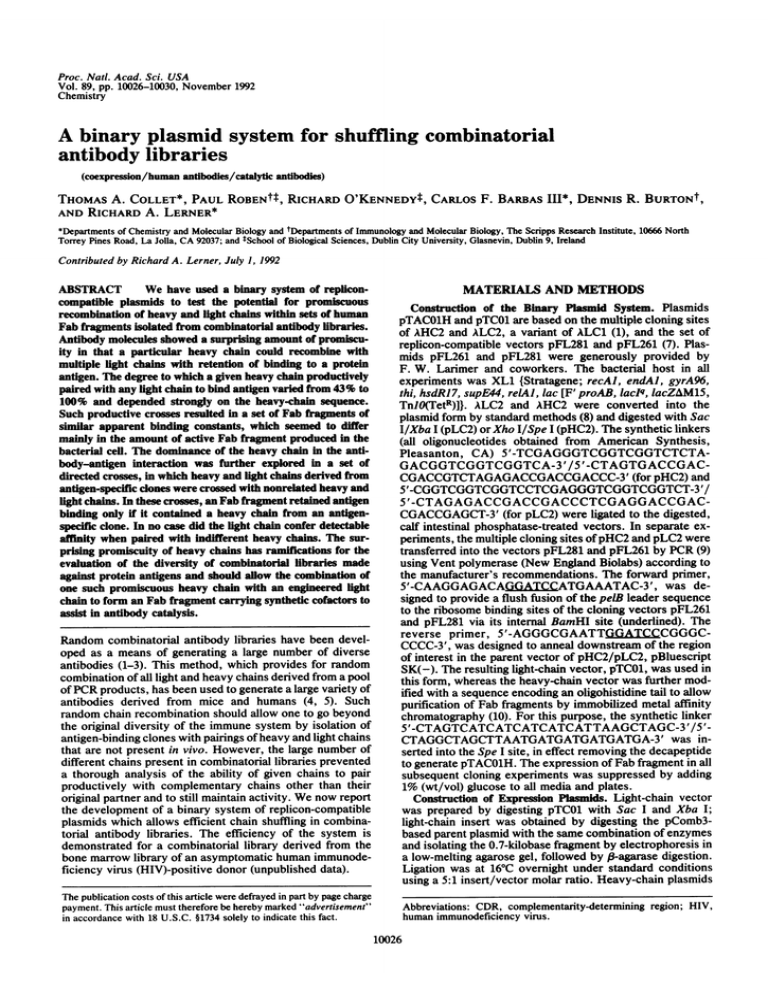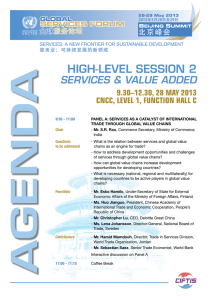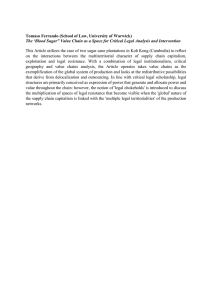shuffling combinatorial libraries binary plasmid system for
advertisement

Proc. Nati. Acad. Sci. USA
Vol. 89, pp. 10026-10030, November 1992
Chemistry
A binary plasmid system for shuffling combinatorial
antibody libraries
(coexpression/human antibodies/catalytic antibodies)
THOMAS A. COLLET*, PAUL ROBENtt, RICHARD O'KENNEDY*, CARLOS F. BARBAS II*, DENNIS R. BURTONt,
AND RICHARD A. LERNER*
*Departments of Chemistry and Molecular Biology and tDepartments of Immunology and Molecular Biology, The Scripps Research Institute, 10666 North
Torrey Pines Road, La Jolla, CA 92037; and tSchool of Biological Sciences, Dublin City University, Glasnevin, Dublin 9, Ireland
Contributed by Richard A. Lerner, July 1, 1992
We have used a binary system of repliconABSTRACT
compatible plasmids to test the potential for promiscuous
recombination of heavy and light chains within sets of human
Fab fragments isolated from combinatorial antibody libraries.
Antibody molecules showed a surprising amount of promiscuity in that a particular heavy chain could recombine with
multiple light chains with retention of binding to a protein
antigen. The degree to which a given heavy chain productively
paired with any light chain to bind antigen varied from 43% to
100% and depended strongly on the heavy-chain sequence.
Such productive crosses resulted in a set of Fab fragments of
similar apparent binding constants, which seemed to differ
mainly in the amount of active Fab fragment produced in the
bacterial cell. The dominance of the heavy chain in the antibody-antigen interaction was further explored in a set of
directed crosses, in which heavy and light chains derived from
antigen-specific clones were crossed with nonrelated heavy and
light chains. In these crosses, an Fab fragment retained antigen
binding only if it contained a heavy chain from an antigenspecific done. In no case did the light chain confer detectable
affinity when paired with indifferent heavy chains. The surprising promiscuity of heavy chains has ramifications for the
evaluation of the diversity of combinatorial libraries made
against protein antigens and should allow the combination of
one such promiscuous heavy chain with an engineered light
chain to form an Fab fragment carrying synthetic cofactors to
assist in antibody catalysis.
Random combinatorial antibody libraries have been developed as a means of generating a large number of diverse
antibodies (1-3). This method, which provides for random
combination of all light and heavy chains derived from a pool
of PCR products, has been used to generate a large variety of
antibodies derived from mice and humans (4, 5). Such
random chain recombination should allow one to go beyond
the original diversity of the immune system by isolation of
antigen-binding clones with pairings of heavy and light chains
that are not present in vivo. However, the large number of
different chains present in combinatorial libraries prevented
a thorough analysis of the ability of given chains to pair
productively with complementary chains other than their
original partner and to still maintain activity. We now report
the development of a binary system of replicon-compatible
plasmids which allows efficient chain shuffling in combinatorial antibody libraries. The efficiency of the system is
demonstrated for a combinatorial library derived from the
bone marrow library of an asymptomatic human immunodeficiency virus (HIV)-positive donor (unpublished data).
MATERIALS AND METHODS
Construction of the Binary Pamrid System. Plasmids
pTACO1H and pTC01 are based on the multiple cloning sites
of AHC2 and ALC2, a variant of ALCi (1), and the set of
replicon-compatible vectors pFL281 and pFL261 (7). Plasmids pFL261 and pFL281 were generously provided by
F. W. Larimer and coworkers. The bacterial host in all
experiments was XL1 {Stratagene; recAl, endAl, gyrA96,
thi, hsdRl7, supE44, relAl, lac [F' proAB, lacIJ, lacZAM15,
TnJO(TetR)]}. ALC2 and AHC2 were converted into the
plasmid form by standard methods (8) and digested with Sac
I/Xba I (pLC2) or Xho I/Spe I (pHC2). The synthetic linkers
(all oligonucleotides obtained from American Synthesis,
Pleasanton, CA) 5'-TCGAGGGTCGGTCGGTCTCTAGACGGTCGGTCGGTCA-3 '/5' -CTAGTGACCGACCGACCGTCTAGAGACCGACCGACCC-3' (for pHC2) and
5'-CGGTCGGTCGGTCCTCGAGGGTCGGTCGGTCT-3'/
5' -CTAGAGACCGACCGACCCTCGAGGACCGAC-
CGACCGAGCT-3' (for pLC2) were ligated to the digested,
calf intestinal phosphatase-treated vectors. In separate experiments, the multiple cloning sites of pHC2 and pLC2 were
transferred into the vectors pFL281 and pFL261 by PCR (9)
using Vent polymerase (New England Biolabs) according to
the manufacturer's recommendations. The forward primer,
5'-CAAGGAGACAGIGAfCCATGAAATAC-3', was designed to provide a flush fusion of the pelB leader sequence
to the ribosome binding sites of the cloning vectors pFL261
and pFL281 via its internal BamHI site (underlined). The
reverse primer, 5 '-AGGGCGAATTGGATCCCGGGCCCCC-3', was designed to anneal downstream of the region
of interest in the parent vector of pHC2/pLC2, pBluescript
SK(-). The resulting light-chain vector, pTCO1, was used in
this form, whereas the heavy-chain vector was further modified with a sequence encoding an oligohistidine tail to allow
purification of Fab fragments by immobilized metal affinity
chromatography (10). For this purpose, the synthetic linker
5'-CTAGTCATCATCATCATCATTAAGCTAGC-3 '/5 'CTAGGCTAGCTTAATGATGATGATGATGA-3' was inserted into the Spe I site, in effect removing the decapeptide
to generate pTACO1H. The expression of Fab fragment in all
subsequent cloning experiments was suppressed by adding
1% (wt/vol) glucose to all media and plates.
Construction of Expression Plasmids. Light-chain vector
was prepared by digesting pTCO1 with Sac I and Xba I;
light-chain insert was obtained by digesting the pComb3based parent plasmid with the same combination of enzymes
and isolating the 0.7-kilobase fragment by electrophoresis in
a low-melting agarose gel, followed by P-agarase digestion.
Ligation was at 16WC overnight under standard conditions
using a 5:1 insert/vector molar ratio. Heavy-chain plasmids
The publication costs of this article were defrayed in part by page charge
payment. This article must therefore be hereby marked "advertisement"
in accordance with 18 U.S.C. §1734 solely to indicate this fact.
Abbreviations: CDR, complementarity-determining region; HIV,
human immunodeficiency virus.
10026
Chemistry: Collet et al.
Proc. Natl. Acad. Sci. USA 89 (1992)
were prepared by digesting pTACO1H with Xho I and Spe I
and ligating it to heavy-chain insert obtained from the
pComb3-based parent plasmid (11) by PCR using Taq polymerase (Promega) according to the manufacturer's conditions and the primers 5'-CAGGTGCAGCTCGAGCAGTCTGGG-3' (VHla) and 5'-GCATGTACTAGTTTTGTCACAAGATTTGGG-3' (CGlz). PCR products were purified
by low-melting agarose electrophoresis, digested with Xho I
and Spe I, repurified, and ligated to the prepared heavy-chain
vector using a 2:1 insert/vector molar ratio.
Cotransformation of Binary Plasmids. CaCl2-competent
XL1 Blue cells were prepared and transformed with -0.5 ,ug
of each purified plasmid DNA, according to standard methods (8). To select for the presence of both plasmids and the
episome, transformants were plated on triple-antibiotic agar
plates [carbenicillin (100 ,ug/ml), chloramphenicol (30 jg/
ml), and tetracycline (10 jig/ml) in LB agar (32 g/liter)]
containing 1% glucose.
Preparation of Recombinant Fab Fragment. Bacterial cultures for determination of antigen-binding activity were
grown (1) in 96-well tissue culture plates (Costar 3596). Two
hundred fifty microliters of superbroth [per liter: 10 g of
3-(N-morpholino)propanesulfonic acid, 30 g of tryptone, 20 g
of yeast extract, pH 7.0 at 25TC] containing chloramphenicol
(30 ,ug/ml), carbenicillin (100 pug/ml) and 1% glucose was
added per well and inoculated with a single doubletransformant. Plates were incubated with moderate shaking
(200 rpm) on a horizontal shaker for 7-9 hr at 37°C, until the
OD550 was 1-1.5. The cells were collected by centrifugation
of the microtiter plate (1500 x g for 30 min at 4°C), the
supernatants were discarded, and the cells were resuspended
and induced overnight at room temperature in fresh medium
containing 1 mM isopropyl (-D-thiogalactopyranoside, but
no glucose. Cells were harvested by centrifugation, resuspended in 175 ,ul of phosphate-buffered saline (10 mM sodium
phosphate/160 mM NaCl, pH 7.4 at 25°C) containing phenylmethylsulfonyl fluoride (34 ,ug/ml) and 1.5% streptomycin
sulfate, and lysed by three freeze-thaw cycles between
-80°C and 37°C. The crude extracts were partially cleared by
centrifugation as above before analysis by antigen-binding
ELISA.
Assay and Determination of Relative Affinities. Relative
affinities were determined (4) after wells were coated with 0.1
,ug of antigen [tetanus toxoid from the Scripps Clinic, IIIB
gpl20 from American Biotechnologies (Columbia, MD) or
SF2 gpl20]. For each antigen, a negative control extract of
10027
XL1 Blue cotransformed with pTCO1 and pTACO1H was
tested to determine whether other components in E. coli had
any affinity for the antigens in our assay. Each extract was
assayed for binding activity with bovine serum albumin, and
albumin-positive clones were considered negative. All possible single-transformants expressing only one chain were
prepared as described for the double-transformants and were
found to have no affinity for any ofthe antigens used; because
ofthe nature of the assay, it could not be determined whether
this was due to a lack of binding by the individual chains itself
or due to a lack of expression or folding.
RESULTS
Construction of the Binary Plasmid System. A binary plasmid system consisting of two replicon-compatible plasmids
was constructed (Fig. 1). The two plasmids feature similar
cloning sites including pelB leader sequences fused to the
ribosome binding sites and the tac promoters via BamHI sites
(Fig. 2). The heavy-chain vector pTACO1H also encodes a
(HiS)s tail to allow purification of the recombinant Fab
fragments by immobilized metal affinity chromatography.
The presence of both plasmids in the same bacterial cell is
selected for by the presence of both antibiotics in the medium. Expression is partially suppressed during growth by
addition of glucose and is induced by the addition of isopropyl
f3-D-thiogalactopyranoside at room temperature. Under
these conditions, both plasmids are stable within the cell and
support expression of the Fab fragment as assayed by ELISA
using goat anti-human K and goat anti-human yl antibodies
(data not shown).
Direct Crosses of Heavy and Light Chains Within a Set of
HIV gpl2O/gpl6O-Binding Antibodies. In the original description (11) of the Fab fragments used in this study, all
fragments, derived from the bone marrow of the same
asymptomatic HIV donor but panned against IIIB gpl20,
IIIB gp160, and SF2 gp120, could be assigned to one of seven
groups based on the amino acid sequences of the third
complementarity-determining region (CDR3) of their heavy
chains (6). From the same library, antibodies to the constrained hypervariable v3 loop-like peptide JSISIGPGRAFYTGZC (6) were isolated. For our chain-shuffling
experiment, we chose representative members of each of the
seven groups (bil; b6; b4, b12, b7, and b21; b3; s8; bl, b14,
and b24; b13, b22, B26, b8, b18, b27, B8, B35, and s4) and one
loop peptide-binding clone (p35) (6). (B followed by the clone
iuI)
...1
I
---
1.1 1Ci
_
U/0IC)
p ILA
1
FIG. 1. Plasmid maps of the
,1):11;li~~~~~~~~~t
t
~ ~
.:
l
I
~
~
~
l
t
: \ \,i.Crlj
-1R('1 " I
I
(
i'
i
.
..
ol7it
Nua
replicon-compatible chain-shuffling vectors. The two plasmids
are very similar in the section
containing the promoter and the
cloning site. tacPO, tac promoter; rbs, ribosome binding
site; H5 tag, region encoding Hiss
tail; fl IG, intergenic region of
fl phage; stu, "stuffer" fragment ready for in-frame replacement by light- or heavy-chain sequences (in pTCO1 or pTACO1H,
respectively); cat, chloramphenicol acetyltransferase gene; bla,
,B-lactamase gene; on, origin of
*..,-,,RI:
(,('fI!?
replication. Maps are drawn approximately to scale.
10028
b+_.~
Chemistry: Collet et al.
A
Proc. Natl. Acad. Sci. USA 89 (1992)
tac promoter
rbs
TGITGACAATTAATCATCGGCTCGTATAA tTGTGGAATTGTGAGCGGATAACAATTTCACAC G-G-ATCC'AQ
SacI
XhoI
pelB leader
BamHI
MetLysTyrLeuLeuProThrAlaAlaAlaGly
ATGAAATACCTATTGCCTACGGCAGCCGCTGGA
XbaI
LeuLeuLeuLeuAlaAlaGlnProAlaMetAlaGluLeu
1 T W1 1 ^1 1 Z4 1 U -UTUUUAAUUUUAUUUA
UUTC-sbbTLW7X'T'G>Tl'b'lQbb-l
STOP
GGTCGGTCGG1TC1 z 1AQAGT1TAAGCGGCC
AACAATAATGAGCGACGGGTTGGTCGGTACCGGCTCGAGCCAGCCAGCCAGGAGCTCCCAGC~CAGCCAGAGATCTCAATTCGCCG7GCG
B
tac promoter
rbs
BamHI
pelB leader
MetLysTyrLeuLeuProThrAlaAlaAlaGly
j-- -- -
-
a arrrpr-rprrer
mt 'A
Itltlm Ao
el-ft
Tr-qrrrp
A er^* Arrtlfro 'Ar
tr a aT
ar Ts
a~Ttr- zarprnr-t-prerrafr
awrtrnrarprrr
-Af ma- A Arprfrre'Aer Afrr~rll
Rx * 'Atf A orrvrrn
I',.vt* tcrvr
asviAAATAl
1vlsuC1TATTUvvvI-lICCTA
vvvt'lvAlCAGCCl
lvt'lACTGGAvXl
ACI CTGTTAATTAGTAGCCGAGCATATTS ACACCTTAACACTCGCCTATTGTTAAAGTGT TCCTCC TCCTAGGTACTTTATGGATAACGGATGCCGTCGGCGACCT
SpeI
(His)5-tail
ThrSerHisHisHisHisHiSSTOP
TTGTTATTACTCGCTGCCCAACCAGCCATGGCCCAGGTGAAACTGCTCGiAGGGTCGGTCGGTCTCTAGACGGTCGGTCGGTCACTAGTCATCATCATCATCATTAAGCTA
AACAATAATGAGCGACGGGTTGGTCGGTACCGGGTCCACTTTGACGAGCTCCCAGCCAGCCAGAGATCTGCCAGCCAGCCAGTGATCAGTAGTAGTAGTAGTAATTCGAT
XhoI
XbaI
LeuLeuLeuLeuAlaAlaGlnProAlaMetAlaGlnValLysLeuLeuGlu
FIG. 2. (A) Nucleotide sequence of multiple cloning site in light-chain vector, pTC01. (B) Nucleotide sequence of multiple cloning site in
heavy-chain vector, pTAC0lH. Relevant restriction sites are underlined. tac promoter and ribosome binding site (rbs) are indicated by boxes.
number denotes a clone obtained by panning against HIV-1
IIIB envelope protein gpl60, b against HIV-1 IIIB envelope
protein gpl20, s against HIV-1 envelope protein SF2 gpl120,
and p against the synthetic loop peptide.) Clones b4, b7, bl2,
and b21 showed neutralization activity against HIV when
inhibition of infection was monitored by syncytium formation, and clones bl3, bl2, and b4 showed activity when
Ihll ISbf 4
t
b11
bl2
+
b8
b~l
w
+
+
+
+
+ +
+
4
t+
f
_
b.22.
_+
+
+
+
+
B26 b8 bl8 b27 B8 B35
w|
_
_
w
b14
b241 s8 IP35
--
__
+_
+
|+
s4I bl
~+- --__+-_.
~
+_
+
+
_
_
sB 6
p35
b21l b3 lbl3-
+ +|+
+
+ +
bl 4 +
hb2
+
hl2 b7
production of the HIV core antigen (p24) was monitored (12).
Light and heavy chains were cloned from the original constructs as described and cotransformed in all possible binary
combinations into XL1 cells. The results of the complete
cross are shown in Fig. 3. As was to be expected, identical
chains derived from diferent Fab fragments had similar
binding properties--e.g., the heavy chains bl8HC, b27HC,
+
w
-
-
_
5
+.
+
+
+ +._+.__|+-
t
t
1~~~~~~~~~~~~~~~~~~~~~~~~~~~......
t
+
+
+
+I- ~ 1+|-
+
w
w
w
+
w
w
w
w
+
FIG. 3. Complete set of directed crosses between heavy and
light chains of all Fab fragments
isolated from the original library
by panning with glycoprotein
gpl20 (bl-b27) or gpl60 (B8-B35)
of HIV-1 strain IIIB, gp120 (s4s8) of HIV-1 strain SF2, and the
loop peptide (p35), assayed by
ELISA against IIIB gp120. Heavy
chains are listed horizontally and
light chains are listed vertically.
Clones are sorted according to the
grouping established in ref. 6. Different groups are separated by
horizontal and vertical lines.
ELISA results: -, negative (a signal of 3 times background or less);
+, positive (comparable to the
original heavy and light chain
combination); w, intermediate
value; , the HCp35/LCp35 combination was negative with IIIB
gpl20 but positive with SF2
gpl20. Identical chains carry the
same identifier (either *,, , or
Chemistry:
Collet
Nati. Acad. Sci. USA 89 (1992)
etet
al.al.
Collet
~~~Proc.
Chemistry:
10029
100r
80
E
60~
cc
401
E
---bl 2HC'bl LC
1~0
O.-
bl 2HC-b3LC
*bl12HC.;b6LC.
bl 2HC .bi 1LC
bl12HC:-bl2LC''l
20:
bl-.
b2HC8;E35LC
bI12 HC/S8LC
-4-_bl2HCl/p35LC
13
I1
-12
Iog(molarity
Affinity of antibody-antigen interaction for
using soluble IIIB gpl2O as competing antigen.
FIG. 4.
ELISA
b12
of
.9
0
11UB
heavy chain
crosses
crosses of the original heavy
original light chains in each case clearly
recapitulated binding activity. Minor differences existed between some heavy chains with identical variable-domain
B8HC, B35HC, and s4HC. The
chains with the
sequences--e.g., b4 and b12
(constant domains
not
were
sequenced for any of the constructs). The exception is b8HC,
which is identical in its variable domain to b18HC, b27HC,
B8HC, B35HC, and s4HC but showed more crossreactivity.
Presumably, this was due to differences in expression levels
in the cell
There
or
were
tendency
gen, but
to
differences in the constant-domain sequences.
clear differences between
crosses.
heavy chains in their
accept different light chains and still bind anti-
even
the least promiscuous
panned against IIIB
gp12O,
heavy chain in the
b1HC, still did
so
set
in 43% of its
On the other side of the spectrum, there
were
gpl2O
five
heavy chains, b11HC, b6HC, b12HC, b7HC, and b8HC, that
crossed productively with all light chains in this set. For the
heavy chain crosses examined in detail (all of s4HC, B35HC,
and B26HC; most of b12HC and b13HC), no significant
differences in apparent binding affinity were found between
Fab fragments using the same heavy chain but different light
chains (Fig. 4).
It is of particular interest that within the original seven
groups that were established according to the sequence of the
CDR3 of the heavy chains (6) and that are indicated by
horizontal and vertical lines in Fig. 3, there is complete
promiscuity; i.e., heavy and light chains within these CDR3determ ined groups are completely promiscuous with each
other. It is equally apparent that between other groups there
is a lack of promiscuity--e.g., between b1HC-b24HC and
-8
aritiger-)
light chains from all
with
bl3LC-s4LC.
pannings
analyzed by competitive
analysis of these sequence-based groups
important which protein antigen the
phage display library was panned against. The exception to
this case is the cross of p35HC with all light chains, in that the
only cross that bound either to gpl2O (SF2 strain) or the
original antigen, the loop peptide, was the cross containing
the original heavy and light chains (data not shown).
Contrary to our initial hopes, sequence alignments between the most and the least promiscuous heavy chains were
not enlightening in that no correlations between promiscuity
and amino acid sequence could be established (Fig. 5).
Unlike the heavy chains there are no light chains that will
cross productively with all heavy chains nor are there any
that are distinguishable from the other light chains by unusually low promiscuity.
IntranigeicCrosses of Heavy and Light Chains. To
it does not
In the
seem
to be
determine whether conclusions derived from the
tetanus toxoid from a different donor for a new set of crosses
(clone 3 in ref. 4). Extracts were probed with tetanus toxoid
with gpl2O of HIV strain IIIB. The data confirm our results
from the gp120 cross experiment in that the binding activity
toward the antigen was determined by the heavy chain. The
heavy chain of clone P3-13 paired with the light chains
b12, b2l, and b14 to yield an Fab fragment with an affinity for
tetanus toxoid; the light chain of P3-13 paired with the heavy
chains of
bil, and b14 to yield an Fab fragment with
an affinity for IIIB gp12O. None of the light chains originating
or
b4,
b3,
CDR3
b6,
HC
b7,
HC
b6,
HC
bl, HC
FIG. 5.
LEESGGGLVKPGGSLRLSCVGSGFTFS
.Q. .AEV...
.ASVKV. .QA. .YR..
LEESGGGLVKPGGSLRLSCVGSGFTFS
...
TEFKP. .S.VKV. .KA. .G. .G
Amino acid
b7). Matches
are
SAWMA
NFVIH
SAWMA
DYASNYAIS
WVRQAPGRGLEWVG
LIKSKADGETTDYATPVKG
RFSISRNNLEDTVYLQM1DSLRADDTAVYYCAT
.M.
.VTFTADTDAN.A.MELR.
.....QRF.
W.NPYNGNKEFSAKFQD
WVRQAPGRGLEWVG
.....0...
.YI.
LIKSKADGETTDYATPVKG
G.TPTSGSADYAQKFQG
..SA
...I....
.R
RFSISRNNLEDTVYLQMDSLRADDTAVYYCAT
.VT..ADRFTPIL.MELR.
comparison of least promiscuous heavy chain of gp12O-panned
by dots. FR, framework region.
indicated
crosses
high-affinity Fab fragments originating from the
same library could be extended to unrelated libraries, we
chose a nonrelated 'yl(K) Fab fragment (P3-13) specific for
between
..IE..I
.R
clones (bi) and most
QKPRYFDLLSGOYRRVAGAFDV
VG.YTW.DSPQDNYYMDV
QKPRYFDLLSGQYRRVAGAFDV
ERRERGWNPRALRGALDF
FR4
WGHGTTVTVSPAST
.KG.KVI. .S...
WGHGTTVTVSPAST
*.0.Q.R.F....
promiscuous heavy chains (b6 and
10030
Chemistry: Coffet et aL
from the gpl20 binders was able to confer gpl20 specificity
in combination with the P3-13 heavy chain. Similarly, the
P3-13 light chain was unable to generate tetanus toxoid
specificity in combination with any of the heavy chains
originating from the gpl20 binders, confirming the dominance
of the heavy chain in the antibody-antigen interaction (13,
14). Interestingly, all three light chains that showed a strong
signal against tetanus toxoid (b4, b12, b21) are members of
the same group when sorted according to the CDR3 sequences of their original heavy chains. As might be expected
from crosses between unrelated libraries, not only was there
a lower degree of promiscuity-i.e., chains paired productively with far fewer complementary chains-but the range of
apparent affinity constants determined by competition
ELISA was much broader (6.3 x 106-6.3 x 108 M-1). The
replacement of the original P3-13 light chain in the P3-13 Fab
fragment with another light chain lowered the affinity of the
Fab for tetanus toxoid by a factor of 10-100 (from 6.3 x 108
M-1 to 6.3 x 106 M-1; data not shown). In the crosses of the
light chain of P3-13 with all the heavy chains of the HIV
pannings, the productive crosses had similar affinities for
IIIB gp120 (2.5 x 107-6.3 x 107 M-1), with the exception of
bl4HC/P3-13LC, whose signal was too weak for a definite
determination of the apparent binding constant. These affinities are =5-fold lower than those of the gpl2O-specific heavy
chains with their original light chains (data not shown).
Proc. Natl. Acad. Sci. USA 89 (1992)
continue sampling randomly from the same pool of binders.
By extension, the promiscuity observed in this system indicates that in libraries constructed using degenerate, chemically synthesized oligonucleotides (15), there should be considerable flexibility in which synthetic heavy chain can pair
with which synthetic light chain to generate an antigenbinding Fab fragment.
Ultimately, we hope to use the chain-shuffling system to
combine the target specificity of a promiscuous heavy chain
with potential cofactors on engineered light chains such as
hydrolytically active metals like zinc (6). The diversity of
combinatorial libraries coupled with chain shuffling should
allow wide exploration of three-dimensional space, thereby
solving the problem of how to approximate molecules in the
ternary complex of antibody, substrate, and cofactor.
Note Added In Proof. The nucleotide sequences corresponding to the
Fab fragments have been deposited with GenBank (L03139-L03180).
We thank Herman Gram for helpful discussions, Arnold Satterthwait for the loop peptide, and Jim Binley and Doug Cababa for the
gp160-panned clones. C.F.B. is a Scholar of the American Foundation for AIDS Research.
1. Huse, W. D., Sastry, L., Iverson, S. A., Kang, A. S., AltingMees, M., Burton, D. R., Benkovic, S. J. & Lerner, R. A.
(1989) Science 246, 1275-1281.
2. Barbas, C. F., III, Kang, A. S., Lerner, R. A. & Benkovic,
DISCUSSION
Combinatorial antibody libraries allow the immunochemical
analysis of antigen binding to be carried far beyond the limits
imposed by the restrictions of the traditional hybridoma
technology. Such libraries not only aim to duplicate the
diversity of the immune system in vitro but may, in combination with synthetic chemical methods (i.e., synthetic libraries), even improve on it in ways not feasible in vivo (15).
Chain shuffling is yet another maneuver allowed in vitro but
not in vivo which can be expected to help extend antibody
diversity beyond that of nature.
The overriding feature of the binary system presented here
is its ability to create large numbers (several hundred) of
directed crosses between characterized light and heavy
chains without the need for recloning individual chains for
each cross after the initial vector construction. When used in
combination with the phage-display method and biological
assays, it allows the rapid analysis of the most interesting
subset of the pool of antigen-binding clones by chain shuffling, with the aim of finding biologically or chemically active
antibodies. For the set of antigens studied here, we found that
most heavy chains will recombine with a number of light
chains to yield an antigen-binding Fab fragment. These
results have important implications for the diversity of combinatorial antibody libraries. While it is not possible to
predict reliably the original in vivo combinations of light and
heavy chains, due to the surprising promiscuity of individual
chains, recombinant antibody libraries may take advantage of
the fact that even distantly related Fab fragments against the
same antigen can recombine in vitro to give chain combinations not found in vivo. In fact, after the identification of a
certain number of antibodies that have been shown to possess
some biological or chemical activity, it may be better to
shuffle their individual chains in a directed fashion than to
S. J. (1991) Proc. Nat!. Acad. Sci. USA 88, 7978-7982.
3. Marks, J. D., Hoogenboom, H. R., Bonnert, T. P., McCafferty, J., Griffiths, A. D. & Winter, G. (1991) J. Mol. Biol. 222,
581-597.
4. Persson, M. A. A., Caothien, R. H. & Burton, D. R. (1991)
Proc. Natl. Acad. Sci. USA 88, 2432-2436.
5. Zebedee, S. L., Barbas, C. F., III, Hom, Y.-L., Caothien,
R. H., Graff, R., DeGraw, J., Pyati, J., LaPolla, R., Burton,
6.
7.
8.
9.
10.
D. R., Lerner, R. A. & Thornton, G. B. (1992) Proc. Nat!.
Acad. Sci. USA 89, 3175-3179.
Iverson, B. L., Iverson, S. A., Roberts, V. A., Getzoff, E. D.,
Tainer, J. A., Benkovic, S. J. & Lerner, R. A. (1990) Science
249, 659-662.
Larimer, F. W., Mural, R. J. & Soper, T. S. (1990) Protein
Eng. 3, 227-231.
Sambrook, J., Fritsch, E. F. & Maniatis, R. (1989) Molecular
Cloning: A Laboratory Manual (Cold Spring Harbor Lab., Cold
Spring Harbor, NY), 2nd Ed.
Gram, H., Marconi, L.-A., Barbas, C. F., III, Collet, T. A.,
Lerner, R. A. & Kang, A. S. (1992) Proc. Nat!. Acad. Sci. USA
89, 3576-3580.
Skerra, A., Pfizinger, I. & Pluckthun, A. (1991) BiofTechnol-
ogy 9, 273-278.
11. Burton, D. R., Barbas, C. F., III, Persson, M. A. A., Koenig,
S., Chanock, R. M. & Lerner, R. A. (1991) Proc. Natl. Acad.
Sci. USA 88, 10134-10137.
12. Barbas, C. F., III, Bjorling, E., Chiodi, F., Dunlop, N.,
Cababa, D., Jones, T. M., Zebedee, S. L., Persson, M. A. A.,
Nara, P. L., Norrby, E. & Burton, D. R. (1992) Proc. Nat!.
Acad. Sci. USA 89, 9339-9343.
13. Wilson, I. A., Stanfield, R. L., Rini, J. M., Arevalo, J. H.,
Schulze-Gahmen, U., Fremont, D. H. & Stura, E. A. (1991)
Catalytic Antibodies, Ciba Foundation Symposium 159 (Wiley,
Chichester, U.K.), pp. 13-39.
14. Ward, E. S., Gdssow, D., Griffiths, A. D., Jones, P. R. &
Winter, G. (1989) Nature (London) 341, 544-546.
15. Barbas, C. F., III, Bain, J. D., Hoekstra, D. M. & Lerner,
R. A. (1992) Proc. Natl. Acad. Sci. USA 89, 4457-4461.






